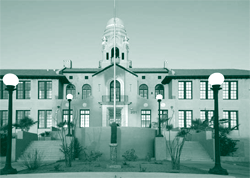February 2009
In this Issue
Preserving a Piece of History
Sharing the Risks and Rewards of Homeownership
Excelling in Housing and Community Design
Housing Counseling with HUD Support
In the next issue of ResearchWorks
Preserving a Piece of History
Ajo, Arizona, is a small town 40 miles north of Mexico and approximately 100 miles from both Phoenix and Tucson. Located in one of the border region's colonias, Ajo has long served as a stop for tourists en route to Mexico and the national deserts. With its recent influx of artisans who reside and work at the Curley School, however, Ajo has become more than just a place to stop along the way; it's become a destination in its own right.

Curley School was built in 1919 during the copper mining boom. Now listed on the National Register of Historic Places, the school was part of a planned "company town" that also featured a plaza, shops, housing, and two white adobe churches. The school's 7-acre campus was composed of eight buildings constructed in the Spanish Colonial Revival style, complete with arches, stucco exteriors, red terra cotta roof tiles, copper accents, and domed towers.
This facility was abandoned and in disrepair when a rural nonprofit, the International Sonoran Desert Alliance, undertook its redevelopment. The rehabilitated mixed-use project offers live/work spaces for 30 artisans and their families. The new apartments, built in a loft style with high ceilings and ample natural light, vary in size from studio to three-bedroom units. In this economically depressed area of Pima County, where half of renters spend at least 30 percent of their income on housing costs, monthly rents for these affordable apartments range from $207 to $625.1 Priority is given to renters who are artists or who own creative home businesses."2 In addition to the apartments, amenities include classrooms, workshops, an indoor-outdoor auditorium, computer lab, and gymnasium. Residents also have access to services such as business development training, employment counseling, health and youth programs, and homeownership assistance.
Benefits from the rehabilitation project have suffused throughout the community, the most obvious being that the project has inspired the renovation or preservation of other local buildings. The influx of artisan residents and their families also counters a pattern of out-migration, bringing employment opportunities to an area that has long suffered from a dwindling employment base.
The redevelopment of Curley School was a community-wide effort that cost $8.9 million. Funding for the project came from a range of governmental and community-based participants, including HUD ($2.5 million), the National Trust for Historic Preservation, the Federal Home Loan Bank, local community organizations and individuals, the National Bank of Arizona (permanent loan), and the state of Arizona. Types of funding used included Pima County (Arizona) bonds, low-income housing tax credit equity ($5.3 million), historic rehabilitation tax credits ($1.5 million), deferred developer fees, and community donations (derived from a capital campaign that enabled the developer to purchase the property).
Because of these efforts, Curley School received the 2008 HUD Secretary's Award for Excellence in Historic Preservation, given jointly with the National Trust for Historic Preservation. This award honors success in advancing the goals of historic preservation while providing affordable housing or expanded economic opportunities, particularly for low- and moderate-income families and individuals.
Details on the HUD Secretary's Award for Historic Preservation, as well as other HUD Secretary Award programs, are available at www.huduser.gov/research/secaward.html. Additional information on Curley School can be found at www.curleyschool.com.
1. American Community Survey, "Pima County, Arizona Data Profiles-4. Selected Housing Characteristics: 2007" at http://factfinder.census.gov.
2. Curley School website (www.curleyschool.com/2006-curley- artisan-lofts/curley-school-qualifications.htm).
|
||||||
|---|---|---|---|---|---|---|

 Subscribe and Thrive
Subscribe and Thrive 
